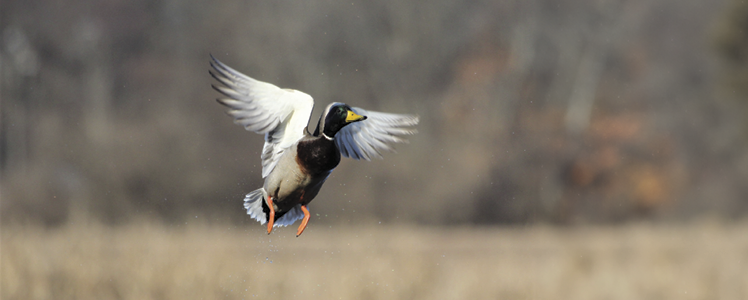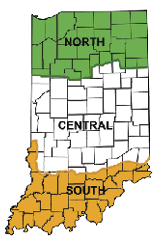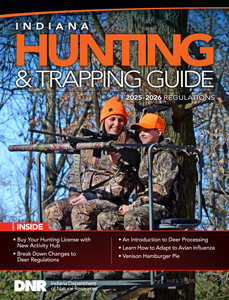Waterfowl & Migratory Bird Regulations

Waterfowl & Migratory Bird Season Dates |
|||
Regular Seasons |
2025-2026 Season Dates |
Bag Limits |
Poss. Limits |
Mourning Doves |
|||
Statewide |
Sept. 1 - Oct. 19, 2025 |
15 ** |
45 ** |
Nov. 1 - Nov. 30, 2025 |
15 ** |
45 ** |
|
Dec. 20-30, 2025 |
15 ** |
45 ** |
|
Sora |
|||
Statewide |
Sept. 1 - Nov. 9, 2025 |
25 |
75 |
American Woodcock |
|||
Statewide |
Oct. 15 - Nov. 28, 2025 |
3 |
9 |
Snipe |
|||
Statewide |
Sept. 1 - Dec. 16, 2025 |
8 |
24 |
Teal |
|||
Statewide * |
Sept. 6-14, 2025 |
6 |
18 |
Ducks, Coots, & Mergansers |
|||
North Zone |
Oct. 18 - Dec. 7, 2025 |
*** |
*** |
Dec. 20-28, 2025 |
*** |
*** |
|
Central Zone |
Nov. 1-9, 2025 |
*** |
*** |
Nov. 22, 2025 - Jan. 11, 2026 |
*** |
*** |
|
South Zone |
Nov. 8-9, 2025 |
*** |
*** |
Nov. 29, 2025 - Jan. 25, 2026 |
*** |
*** |
|
Canada Geese, Light geese, & Brant |
|||
North Zone |
Sept. 1-10, 2025 |
**** |
**** |
Oct. 18-26, 2025 |
**** |
**** |
|
Nov. 22, 2025 - Feb. 15, 2026 |
**** |
**** |
|
Central Zone |
Sept. 1-10, 2025 |
**** |
**** |
Nov. 1-9, 2025 |
**** |
**** |
|
Nov. 22, 2025 - Feb. 15, 2026 |
**** |
**** |
|
South Zone |
Sept. 1-14, 2025 |
**** |
**** |
Nov. 8-12, 2025 |
**** |
**** |
|
Nov. 22, 2025 - Feb. 15, 2026 |
**** |
**** |
|
White-fronted Geese |
|||
North Zone |
Nov. 22, 2025 - Feb. 15, 2026 |
2 |
6 |
Central Zone |
Nov. 22, 2025 - Feb. 15, 2026 |
2 |
6 |
South Zone |
Nov. 22, 2025 - Feb. 15, 2026 |
2 |
6 |
Veteran & Youth Waterfowl Hunting Days (ducks, geese, mergansers, & coots) |
||
Zones |
Dates |
Bag Limits |
North Zone |
Oct. 11-12, 2025 |
Same as Regular Season ***** |
Central Zone |
Oct 25-26, 2025 |
Same as Regular Season ***** |
South Zone |
Nov. 1-2, 2025 |
Same as Regular Season ***** |
Zones
North: Segment of Indiana north of a line extending east from the Illinois border along State Road 18 to U.S. 31; north along U.S. 31 to U.S. 24; east along U.S. 24 to Huntington; southeast along U.S. 224; south along State Road 5; and east along State Road 124 to the Ohio border.
Central: Segment of Indiana south of the North Zone boundary and north of the South Zone boundary.
South: Segment of Indiana south of a line extending east from the Illinois border along I-70; east along National Ave.; east along U.S. 150; south along U.S. 41; east along State Road 58; south along State Road 37 to Bedford; and east along U.S. 50 to the Ohio border.

State and Federal Regulations
- Based on an individual’s age, the following are needed to hunt waterfowl in Indiana:
- Youth 15 and younger: Valid hunting license and HIP number
- Youth 16-17: Valid youth hunting license, HIP number, and Federal Duck Stamp
- Adults 18+: Valid hunting license, HIP number, Federal Duck Stamp, and State Waterfowl Stamp
- Lifetime license holders and those exempt from Indiana license and stamp requirements must still obtain a Federal Duck Stamp and HIP number to hunt waterfowl.
- Migratory gamebirds may be hunted from a motorboat provided it is beached, resting at anchor, tied to a stationary object, or without motion other than that imparted by wind, current acting upon the hull, or hand-operated oars or paddles.
- Hunters may retrieve dead or injured birds by hand or from a motorboat under power but may NOT shoot from a boat under power or in motion due to motor power.
- Migratory gamebirds in a hunter’s possession must have one fully feathered wing or head attached to the carcass for identification when the hunter is in the field or traveling from the field to home.
- All migratory gamebirds killed or crippled shall be retrieved, and retained in the custody of the hunter in the field.
- No person shall give, put, or leave any migratory gamebirds at any place or in the custody of another person unless the birds are tagged by the hunter with the hunter’s signature, address, total number of birds involved by species, and dates birds were killed.
- No person or business shall receive or have in custody any migratory gamebirds belonging to another person unless such birds are properly tagged.
- Shooting hours for all migratory birds (except for teal during early teal season) is one-half hour before sunrise to sunset.
- Nontoxic shot is required when hunting migratory waterfowl. It is also required when hunting mourning doves on DNR properties.
Reminders
- Indiana enforces all federal migratory bird laws. Violating any provision of a state law regarding federally protected migratory birds is also a violation of federal law.
- State stamps can be purchased from authorized hunting and fishing license vendors or online through the Go Outdoors Indiana website. To find locations selling Federal Duck Stamps, visit the U.S. Fish & Wildlife Service Duck Stamps page.
Harvest Information Program (HIP)
HIP is a joint effort of the U.S. Fish and Wildlife Service and state wildlife agencies.
The program is designed to derive harvest estimates for migratory gamebirds nationwide. Once harvest information is gathered, the information is used by the U.S. Fish and Wildlife Service and states to ensure decisions regarding migratory gamebird hunting seasons are based on sound scientific evidence.
All hunters in Indiana, including those exempt from purchasing a license, must register with HIP before hunting coots, doves, ducks, mergansers, geese, snipe, sora, teal, and woodcock.
Hunters are required to register before participating by visiting the Go Outdoors Indiana website or calling 260-323-5378. At the end of the registration, the hunter is given a validation number to record on their license. This number is valid from the date of registration through the close of the last current migratory bird hunting season.
Lifetime license holders and those exempt from Indiana license and stamp requirements must also register with HIP.
Hunters need to register with HIP only once each season, not each time they hunt; however, hunters must register in each state they hunt.
In addition to providing name and address, hunters are asked questions designed to identify which species they hunted last year and, in some cases, the number of birds they harvested.
Waterfowl Hunting on State Properties
Hunters can apply for reserved waterfowl hunts by completing the online application available on the Indiana DNR Reserved Hunt page.
For more information concerning waterfowl hunting on state-owned properties, contact the property (see Public Hunting Areas).
Restrictions
No person shall take migratory gamebirds:
- With a trap, snare, net, rifle, pistol, swivel gun, shotgun larger than 10 gauge, punt gun, battery gun, machine gun, fish hook, poison, drug, explosive, or stupefying substance.
- With a shotgun capable of holding more than three shells, unless it is plugged with a one-piece filler that is incapable of being removed without disassembling the gun.
- From a sink box (a low, floating device, having a depression affording the hunter a means of concealment beneath the surface of the water).
- From any aircraft or with the aid or use of a car or other motor-driven land vehicle, except that persons with paraplegia and persons with single or double amputees of the legs may hunt from any stationary motor vehicle or stationary motor-driven land vehicle.
- By the use or aid of live decoys. All tame or captive live ducks and geese shall be removed for a period of 10 consecutive days prior to hunting and confined within an enclosure that substantially reduces the audibility of their calls and totally conceals such tame birds from the sight of migratory waterfowl.
- By driving, rallying, or chasing birds with any motorized vehicle or any sailboat to put them in the range of the hunters.
- By baiting or by hunting on or over any baited area, if the person knows or reasonably should know that the area is baited. Baiting includes the placing of corn, wheat or other grain, salt, or other feed to serve as a lure or attraction for migratory gamebirds to, on, or over areas where hunters are attempting to take them. It is a separate offense to place, or direct placement of bait, on or adjacent to an area for the purpose of causing or allowing hunters to take or attempt to take birds. A baited area is considered to be baited for 10 days after complete removal of any bait. The maximum federal penalties for hunting over bait are $15,000/6 months jail time and for placing bait are $100,000/1 year jail time. For detailed information about baiting regulations and game bird seasons, visit the Indiana DNR Game Bird Seasons page.
- By the use of recorded or electronically amplified bird calls or sounds, or recorded or electronically amplified imitations of bird calls or sounds.
Nontoxic Shot
Hunters are required to use approved nontoxic shot while hunting all waterfowl (ducks, including teal and mergansers, coots, and geese). Hunters are also required to use nontoxic shot to hunt mourning doves on DNR properties. Some DNR properties have additional nontoxic shot restrictions for other species. Nontoxic shot currently approved for use by the U.S. Fish and Wildlife Service are:
bismuth-tin
copper-clad iron
corrosion-inhibited copper
iron (steel)
iron-tungsten
iron-tungsten-nickel
tungsten-bronze
tungsten-iron-copper-nickel
tungsten-iron-polymer
tungsten-matrix
tungsten-polymer
tungsten-tin-bismuth
tungsten-tin-iron
tungsten-tin-iron-nickel
Coatings of copper, nickel, tin, zinc, zinc chloride, zinc chrome, and fluoropolymers on approved nontoxic shot types are allowed. Lead shot plated with copper, nickel, or other material does not qualify.
It is illegal to possess shells loaded with anything other than approved non-toxic shot while hunting ducks, geese, and coots anywhere in the state. It is illegal to possess lead shot while hunting mourning doves on any state-managed property.
The use of lead shot for hunting waterfowl was banned nationwide in 1991.

